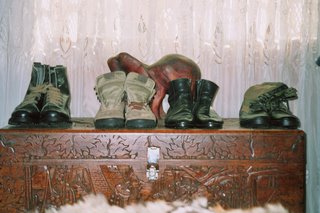I am still doing archival description and am on box 378 out of 387 boxes. Something I forgot to mention is that earlier this week I was going through a box marked "general correspondence" and came across a signed book by David Backman (
Beckman: David Beckman My World Photography by Dean Freeman). I am not a fan of soccer or David Beckman, but I still thought it was pretty cool. While going through another box of general correspondence yesterday, I came across letters from Jimmy Carter and Bill Clinton! (for all my American classmates...)
Last Thursday the Foundation hosted ten grade twelve students from the Erasmus Monareng Secondary School in Vosloruus. The students discussed the first three comic books under the Madiba Legacy Series. The students and NMF staff also listened to accounts by Mrs. Amina, Mrs. Alina Mkhwanazi and Mr. Peter Magubane, who shared stories of their experiences of the protest marches of the 1950s and 1960s.
Peter Magubane is a photographer. He brought with him photographs of the student uprising in Soweto on the
16 June 1976. The photos were powerful images, some of them horrifying, but still very powerful. Mr. Magubane was also attacked by the South African Police that day and had his nose broken. More upsetting to him was the fact that the police made him expose some of his film. He stated, "I fought my struggle with my camera." He said that he knew his nose would eventually heal, but the images that had been exposed to the sunlight were lost forever. Some of the students that day also did not want photographs taken, but Mr. Magubane talked to them and convinced them in stating "There is no struggle unless it is documented properly." Peter Magubane published a book,
Soweto: The Fruit of Fear in 1987, which is a photographic account of the June 16th uprising in Soweto.
That afternoon, our coworkers Shadrack and Boniswa took us to Soweto. We visited the
Hector Peterson Museum and the house Nelson Mandela used to live in during his time in Soweto. Both Jill and I were pleasantly surprised. There has been a lot of economic development in Soweto and it is no longer the shanty town in my mind as depicted in Paton's
Cry the Beloved Country. Boniswa made friends wherever we went which resulted in free tee shirts and hats at the Mandela Family
Museum in Soweto. They even had some of Mandela's old boots (which I took entirely too many photos of) on display in the bedroom of the house.






